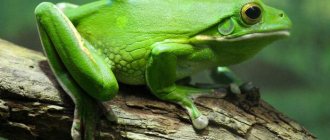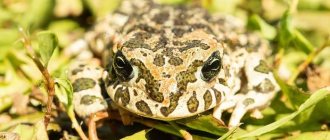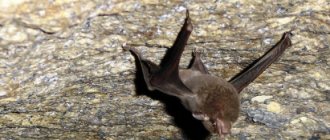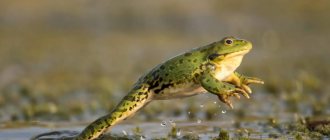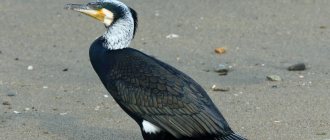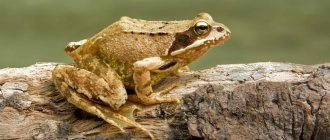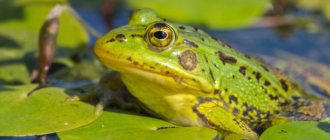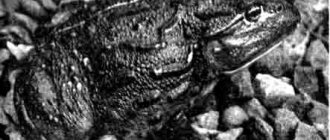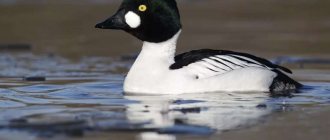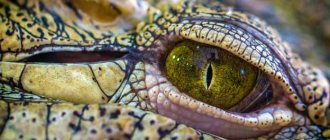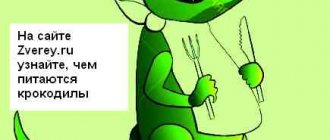The frog's life cycle, gametogenesis, fertilization and other seasonal events depend on numerous external factors. The life of almost all amphibians depends on the number of plants and insects in the pond, as well as the temperature of the air and water. There are various stages of development of frogs, including the larval stage (egg - embryo - tadpole - frog). The metamorphosis of a tadpole into an adult is one of the most striking transformations in biology, as these changes prepare an aquatic organism for terrestrial existence.
Development of frogs: photo
In tailless amphibians, such as frogs and toads, metamorphic changes are most pronounced, almost every organ undergoes modification. The shape of the body changes beyond recognition. After the appearance of the hind and fore limbs, the tail gradually disappears. The cartilaginous skull of the tadpole is replaced by the facial skull of a young frog. The horny teeth that the tadpole used to eat pond plants disappear, the mouth and jaws take on a new shape, and the tongue muscles develop stronger to make it easier to catch flies and other insects. The elongated colon characteristic of herbivores is shortened to accommodate the carnivorous diet of the adult. At a certain stage of frog development, the gills disappear and the lungs increase.
Breeding toads at home
Recently it has become fashionable to keep amphibians at home. For their comfortable maintenance, special terrariums are used. They are placed in secluded corners of the apartment, avoiding direct rays of the sun and away from the source of loud sounds. The terrariums need to be cleaned periodically. These “pets” should only be handled by wearing gloves. Any living insect is suitable as food for toads. Some types of toads become tamed quite quickly and even take food from the hands of a caring owner.
- In the birth of offspring in some species of toads, the male father is maximally involved: a representative of one of the species of toads living in Europe, the “father” of the future family sits in an earthen hole with ribbons of eggs wound around his paw until the tadpoles begin to hatch .
- The myth that a toad can “give” warts is absolutely unrealistic! Even if you pick it up, you don’t risk anything: all toads, except the aga, are completely safe.
- Due to their gluttony and active “hatred” of mosquitoes, slugs, flies and similar insects, in some countries toads are bred specifically to be used in the future to combat annoying pests of garden and vegetable crops.
Few people like amphibians: it’s good if they simply bypass a frog or toad, but often they try to harm the animal! Unmotivated aggression on the part of a person can only be explained by his narrow-mindedness - it is strange to want to offend such an animal as the toad, if you know at least a little about it.
What happens immediately after fertilization?
Soon after fertilization, the egg begins to move from one cellular stage to another through the process of division. The first cleavage begins at the animal pole and proceeds vertically down to the vegetal pole, dividing the egg into two blastomeres. The second cleavage occurs at right angles to the first, dividing the egg into 4 blastomeres. The third furrow is located at right angles to the first two, being closer to the animal than to the vegetative pole. It separates the four upper small pigmented areas from the four lower ones. At this stage, the embryo already has 8 blastomeres.
Further splits become less regular. As a result, the one-celled egg gradually turns into a one-celled embryo, which at this stage is called a blastula, which, even at the stage of 8-16 cells, begins to acquire fluid-filled spatial cavities. After a series of changes, the single-layer blastula turns into a two-layer embryo (gastrula). This complex process is called gastrulation. The intermediate stages of frog development at this stage involve the formation of three protective layers: ectoderm, mesoderm and endoderm, which are also known as the primordial germ layers. Later, larvae hatch from these three layers.
Nutrition
Each amphibian has its own small habitat, which they thoroughly search for food. These amphibians feed on invertebrates: bugs, bugs, worms, caterpillars, even newborn lizards, snakes and mice, and their favorite dish is naked slugs. Prey can be seen at a distance of up to three meters. They hunt using their tongue, to which the prey sticks. If it is large, then the toad helps itself with the help of its front legs. Gray toads are very voracious, but even this fact does not allow them to eat dead animals.
The gray toad, whose lifestyle is of great interest to scientists, was a participant in an interesting experiment. Its goal was to reveal aggression and hostility towards its relatives. The essence of the experience is quite simple. A leaf with honey was placed next to the toad. He attracted insects. A large accumulation of them aroused the interest of another toad. And she came to foreign territory. The owner of the area did not react to this at all. The two of them began to calmly enjoy their meal. And even when they hunted the same insect, and one stole the other’s prey, this did not in any way affect their external behavior. They continued to eat quietly. This experience suggests that these are very peaceful and non-conflict amphibians.
Tadpoles (larval stage)
The next stage of frog development after the embryo is the larva, which leaves the protective shell within 2 weeks after fertilization. After the so-called release, the frog larvae are called tadpoles, which are more like small fish about 5-7 mm long. The larva's body includes a distinct head, trunk, and tail. The role of the respiratory organs is played by two pairs of small external gills. A fully formed tadpole has organs adapted for swimming and breathing; the lungs of the future frog develop from the pharynx.
Hibernation
The gray toad is the most resistant to cold among its relatives. It goes into hibernation only in September and October. It survives the winter in various places: under dry leaves, under logs, in pipes, sometimes buries itself in silt or digs holes on its own (which happens extremely rarely). Basically, toads use other people's minks for wintering. When a gray toad climbs into a hole, it blocks the entrance with earth, which prevents cold from entering from the outside. Amphibians awaken at the end of March, at temperatures not lower than +5 degrees Celsius. Then they go to the breeding grounds.
Unique metamorphoses
The aquatic tadpole undergoes a series of changes that eventually transform it into a frog. During metamorphosis, some larval structures are reduced and some are changed. Metamorphoses initiated by thyroid function can be divided into three categories. 1. Changes in appearance. The hind limbs grow, joints develop, and fingers appear. The forelimbs, still hidden by special protective folds, extend outward. The tail shrinks, its structures break down and gradually nothing remains in its place. The eyes move from the sides to the top of the head and become bulging, the lateral line organ system disappears, the old skin is shed, and new skin, with more skin glands, develops. The horny jaws fall off along with the larval skin and are replaced by true jaws, first cartilaginous and then bone. The mouth gap increases significantly, allowing the frog to feed on large insects. 2. Changes in internal anatomy. The gills begin to lose their importance and disappear, the lungs become more and more functional. Corresponding changes occur in the vascular system. Now the gills gradually cease to play a role in blood circulation, more blood begins to flow into the lungs. The heart becomes three-chambered. The transition from a predominantly plant-based diet to a purely carnivorous diet affects the length of the alimentary canal. It shrinks and curls. The mouth becomes wider, the jaws develop, the tongue becomes larger, and the stomach and liver also become larger. The pronephros is replaced by mesospheric buds. 3. Lifestyle changes. During the transition from the larva to the adult stage of development of frogs, with the onset of metamorphosis, the lifestyle of the amphibian changes. It often rises to the surface to take a breath of air and inflate its lungs.
Mating games
Voice
Most male toads and frogs attract females of their species by voice, namely by croaking, which varies from species to species: in one species it is similar to the “trill” of a cricket, and in another it is similar to the usual “kva-kva” . You can easily find the voices of males on the Internet. The loud voice in the pond belongs to the males, while the females have a very quiet voice or no voice at all.
Courtship
- Appearance and color.
The males of many species of frogs, for example, tropical dart frogs, change their color during mating time and become black. Males, unlike females, have larger eyes, better developed sensory organs and an enlarged brain, respectively, and the front paws are decorated with so-called nuptial calluses, which are necessary for mating so that the chosen one cannot escape.
- Dance
The attention of females can be attracted by various movements . Colostethus trinitatis simply jump rhythmically on a branch, and Colostethus palmatus gets into exquisite poses when they see a female on the horizon, and other species living near waterfalls manage to wave their paws at the females.
Colostethus collaris males perform a courtship dance. The male crawls up to the female and croaks louder and faster, then crawls away, sways and jumps, while freezing on his hind legs in a vertical position. If the female is not impressed by the performance, she raises her head, showing her bright yellow throat, this discourages the male. If the female liked the male’s dance, then she watches the beautiful dance, crawling to different places to better see the male’s play.
Sometimes a large audience can gather: once scientists, observing Colostethus collaris, counted eighteen females that stared at one male and synchronously moved to another position. Having danced, the male slowly leaves, often turning around to make sure that the lady of his heart is following him.
In golden poison dart frogs, on the contrary, females fight for males . Having found a male who is croaking, the female slaps her hind legs on his body and places her front paws on him, and may also rub her head against the male's chin. The male with less ardor responds in kind, but not always. Many cases have been recorded when fights arose in this species of amphibian both between females and males for the partner they liked.
Interesting: What do hippos eat?
A baby frog is a miniature version of an adult frog.
From 12 weeks of age, the tadpole has only a small remnant of a tail and appears to resemble a smaller version of the adult, which has typically completed a full growth cycle by 16 weeks. The development and species of frogs are interrelated, some frogs that live at high altitudes or in cold places can live in the tadpole stage all winter. Certain species may have their own unique developmental stages that differ from traditional ones.
Fear or help for a gardener?
What should you do if you suddenly encounter a ground toad in your garden or vegetable garden? Is it possible to touch it, will it spoil the harvest? Or maybe he will bring friends and there will be nowhere to hide from the toads?
In order to answer the question of what toads do in the garden, you need to find out what ground toads eat.
Their main food is insects. They do not disdain caterpillars, various centipedes, and snails. The toad cannot be frightened by the bright colors or unusual appearance of the insect. Having seen the object for breakfast, the toad waddles towards its goal.
What is the benefit for the gardener? The most direct! Ground toad is an excellent organic way to control pests and crop eaters. She is a kind of crop nurse who goes out in the evenings to walk around the entrusted territory.
Therefore, if you encounter this amphibian on your way or in your garden, you do not need to be like medieval Europeans and run for an “anti-toad” antidote or pesticide. Do not hit the animal or stomp on it: give way, because it is going about its important business, fulfilling its natural function. And its side effect is a benefit for humans.
The gray toad, described in the article, is the largest toad in Europe. Scientists have long been interested in this amphibian.
Life cycle of a frog
Most frogs breed during the rainy season, when ponds are flooded with water. Tadpoles, whose diet differs from that of adults, can take advantage of the abundance of algae and vegetation in the water. The female lays eggs in a special protective jelly under water or on plants located nearby, and sometimes does not even care about the offspring. Initially, the embryos absorb their yolk reserves. Once the embryo has developed into a tadpole, the jelly dissolves and the tadpole emerges from its protective shell. The development of frogs from eggs to adults is accompanied by a number of complex changes (the appearance of limbs, reduction of the tail, internal restructuring of organs, and so on). As a result, an adult animal in its structure, lifestyle and habitat differs significantly from previous stages of development.
An amphibian with a bad reputation
Dislike for toads goes down through generations. Even in the Middle Ages, these animals were treated with special contempt and fear. In all civilized countries it was believed that touching a toad meant certain death. Moreover, the cause of death was allegedly the poison secreted by the toad through the skin.
Also, its insidiousness and danger for our ancestors lay in the fact that a person could become a kind of incubator for them. They explained it this way: you can drink toad eggs with bad or untreated water, and once in the stomach they will hatch safely and begin active life. For a modern person this sounds crazy, but previously such a condition was treated very actively.
Science has proven that the toad poses no danger to humans. Yes, in the event of an extreme situation for itself, the earth toad can release a special protective secretion from its skin, but it rather serves a deterrent role and will not cause any harm.
Natural enemies
She has plenty of enemies: birds of prey, snakes, hedgehogs, and rats. But the worst enemy is man. For many people, the gray toad is an ugly, useless and even harmful animal. But this opinion is far from reality. They, of course, do not shine with their beauty. They are poisonous, but this is only for protection purposes. After all, they simply physically cannot run away from their enemies. Because nature made them large and clumsy. Therefore, they compensated for their physical deficiencies with poisonous glands on their bodies. And from the point of view of benefits for humans, the toad is a very useful neighbor. It can eat up to 60% of pests in the garden. The gray toad is a very valuable and useful ally for humans, although not the most beautiful. But due to its nocturnal lifestyle, this is not scary.
Sense organs
The sense organs are more complex than those of fish; they provide orientation for amphibians in water and on land. Adult amphibians living in water have developed lateral line organs; they are scattered on the surface of the skin, especially numerous on the head. The epidermal layer of the skin contains temperature, pain and tactile receptors. The olfactory organ is represented by paired olfactory sacs, which open outward with paired external nostrils, and into the oropharyngeal cavity with internal nostrils. Some of the walls of the olfactory sacs are lined with olfactory epithelium. The olfactory organs work only in the air; in water, the external nostrils are closed. The olfactory organs of amphibians and higher chordates are part of the respiratory tract.
The cornea of the eye is convex, the lens has the shape of a biconvex lens. The retina contains rods and cones. Many amphibians have developed color vision.
In the hearing organs, in addition to the inner ear, the middle ear is developed. It contains a device that amplifies sound vibrations. The external opening of the middle ear cavity is covered with an elastic eardrum. The cavity contains the auditory ossicle. The middle ear cavity is connected by a narrow canal to the oral cavity.
Population and species status
All species of toads that are on the verge of extinction are listed in the Red Book. These include viviparous toads of the African continent, reed toads, and miniature Kihansi toads. It is a pity that man has contributed his hands to this huge problem, mindlessly interfering with living nature, upsetting its balance, which is fraught with unpredictable consequences. By building a dam on the river where Kihansi lived, people deprived this amphibian of its usual habitat. As a result, this unique creation of nature can now only be seen in a zoo.
Source
